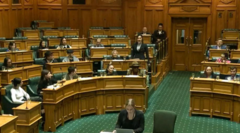An oil painting of a Māori elder has made headlines by fetching a record price at an auction on Tuesday, now recognized as the most valuable artwork of its kind in New Zealand history. This impressive piece, created by the esteemed local artist Charles Frederick Goldie in 1938, portrays Wharekauri Tahuna, a priest believed to be among the last tattooed individuals of his era. The striking sale amount of NZ$3.75 million (approximately $2.2 million) not only sets a new record for Māori portraits but also establishes it as the highest price ever paid for a painting at auction in New Zealand, according to the auction house.
The auction occurs during a time of heightened racial sensitivities in New Zealand, particularly after the government proposed a controversial bill that many Māori leaders argue would infringe upon their rights. Goldie produced "Thoughts of a Tohunga" nine years before his death in 1947, and art critics regard it as one of his finest works. The painting captures the priest adorned with a moko, or facial tattoo, and a hei-tiki pendant, symbolizing cultural significance and deep Māori heritage.
Richard Thomson, director of the International Art Centre, explained to the BBC that the painting had not been on sale for 33 years and highlighted Goldie's legacy within the Māori community, stating, “Goldie was well loved by Māori during his lifetime,” illustrating his harmonious relationship with his subjects in Auckland. Since 2016, the art center has sold 13 of Goldie’s works, with prices exceeding a million New Zealand dollars each time, indicating a strong interest among collectors.
While Māori people represent about 18% of New Zealand's population, persistent socio-economic disparities remain evident, as reflected in markers such as health outcomes, education levels, and life expectancy, which shows a gap of seven years compared to the general population. In parallel with this auction event, a political party's quest to pass a bill reinterpreting the Treaty of Waitangi—the foundational agreement made between Māori and the Crown—stirred significant social unrest. A march opposing the bill drew thousands for nine days, ultimately resulting in the bill's failure to pass.
The intertwined stories of artistic triumph and ongoing cultural struggles underscore a pivotal moment for Māori identity in New Zealand, capturing the historical resonance of Goldie's work alongside contemporary challenges faced by Māori communities.















